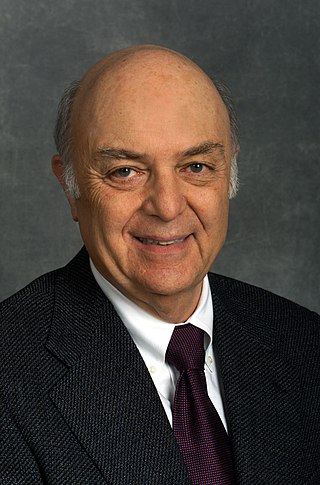The λ (lambda) universality class is a group in condensed matter physics. It regroups several systems possessing strong analogies, namely, superfluids, superconductors and smectics. All these systems are expected to belong to the same universality class for the thermodynamic critical properties of the phase transition. While these systems are quite different at the first glance, they all are described by similar formalisms and their typical phase diagrams are identical.
Jozef T. Devreese was a Belgian scientist, with a long career in condensed matter physics. He was professor emeritus of theoretical physics at the University of Antwerp. He died on November 1, 2023.

Marvin Lou Cohen is an American–Canadian theoretical physicist. He is a physics professor at the University of California, Berkeley. Cohen is a leading expert in the field of condensed matter physics. He is widely known for his seminal work on the electronic structure of solids.
Quantum dimer models were introduced to model the physics of resonating valence bond (RVB) states in lattice spin systems. The only degrees of freedom retained from the motivating spin systems are the valence bonds, represented as dimers which live on the lattice bonds. In typical dimer models, the dimers do not overlap.
Patrick A. Lee is a professor of physics at the Massachusetts Institute of Technology (MIT).

Xiao-Gang Wen is a Chinese-American physicist. He is a Cecil and Ida Green Professor of Physics at the Massachusetts Institute of Technology and Distinguished Visiting Research Chair at the Perimeter Institute for Theoretical Physics. His expertise is in condensed matter theory in strongly correlated electronic systems. In Oct. 2016, he was awarded the Oliver E. Buckley Condensed Matter Prize.
Within quantum cryptography, the Decoy state quantum key distribution (QKD) protocol is the most widely implemented QKD scheme. Practical QKD systems use multi-photon sources, in contrast to the standard BB84 protocol, making them susceptible to photon number splitting (PNS) attacks. This would significantly limit the secure transmission rate or the maximum channel length in practical QKD systems. In decoy state technique, this fundamental weakness of practical QKD systems is addressed by using multiple intensity levels at the transmitter's source, i.e. qubits are transmitted by Alice using randomly chosen intensity levels, resulting in varying photon number statistics throughout the channel. At the end of the transmission Alice announces publicly which intensity level has been used for the transmission of each qubit. A successful PNS attack requires maintaining the bit error rate (BER) at the receiver's end, which can not be accomplished with multiple photon number statistics. By monitoring BERs associated with each intensity level, the two legitimate parties will be able to detect a PNS attack, with highly increased secure transmission rates or maximum channel lengths, making QKD systems suitable for practical applications.
Searches for Lorentz violation involving photons provide one possible test of relativity. Examples range from modern versions of the classic Michelson–Morley experiment that utilize highly stable electromagnetic resonant cavities to searches for tiny deviations from c in the speed of light emitted by distant astrophysical sources. Due to the extreme distances involved, astrophysical studies have achieved sensitivities on the order of parts in 1038.
Quantum illumination is a paradigm for target detection that employs quantum entanglement between a signal electromagnetic mode and an idler electromagnetic mode, as well as joint measurement of these modes. The signal mode is propagated toward a region of space, and it is either lost or reflected, depending on whether a target is absent or present, respectively. In principle, quantum illumination can be beneficial even if the original entanglement is completely destroyed by a lossy and noisy environment.

Edward Ott is an American physicist most noted for his contributions to the development of chaos theory.
Jürgen Mlynek is a German physicist and was president of the Helmholtz Association of German Research Centres from 2005 to 2015.

Roberto Morandotti is a physicist and full Professor, working in the Energy Materials Telecommunications Department of the Institut National de la Recherche Scientifique. The work of his team includes the areas of integrated and quantum photonics, nonlinear and singular optics, as well as terahertz photonics.
James Michael Lattimer is a nuclear astrophysicist who works on the dense nuclear matter equation of state and neutron stars. He is currently a distinguished professor at Stony Brook University.
James (Jim) P. Eisenstein was the Frank J. Roshek Professor of Physics and Applied Physics at the physics department of California Institute of Technology.

Carlos O. Lousto is a Distinguished Professor in the School of Mathematical Sciences in Rochester Institute of Technology, known for his work on black hole collisions.
Bose–Einstein condensation of polaritons is a growing field in semiconductor optics research, which exhibits spontaneous coherence similar to a laser, but through a different mechanism. A continuous transition from polariton condensation to lasing can be made similar to that of the crossover from a Bose–Einstein condensate to a BCS state in the context of Fermi gases. Polariton condensation is sometimes called “lasing without inversion”.
Frans Pretorius is a South African and Canadian physicist, specializing in computer simulations in astrophysics and numerical solutions of Einstein's field equations. He is professor of physics at Princeton University and director of the Princeton Gravity Initiative.
Terry Schalk is an American physicist currently professor emeritus at University of California, Santa Cruz and an Elected Fellow of the American Association for the Advancement of Science.

Sydney Meshkov was a Theoretical Physicist who worked in gravitational wave, atomic, nuclear and particle physics.
Bogdan Andrei Bernevig is a Romanian Quantum Condensed Matter Professor of Physics at Princeton University and the recipient of the John Simon Guggenheim Fellowship in 2017.






